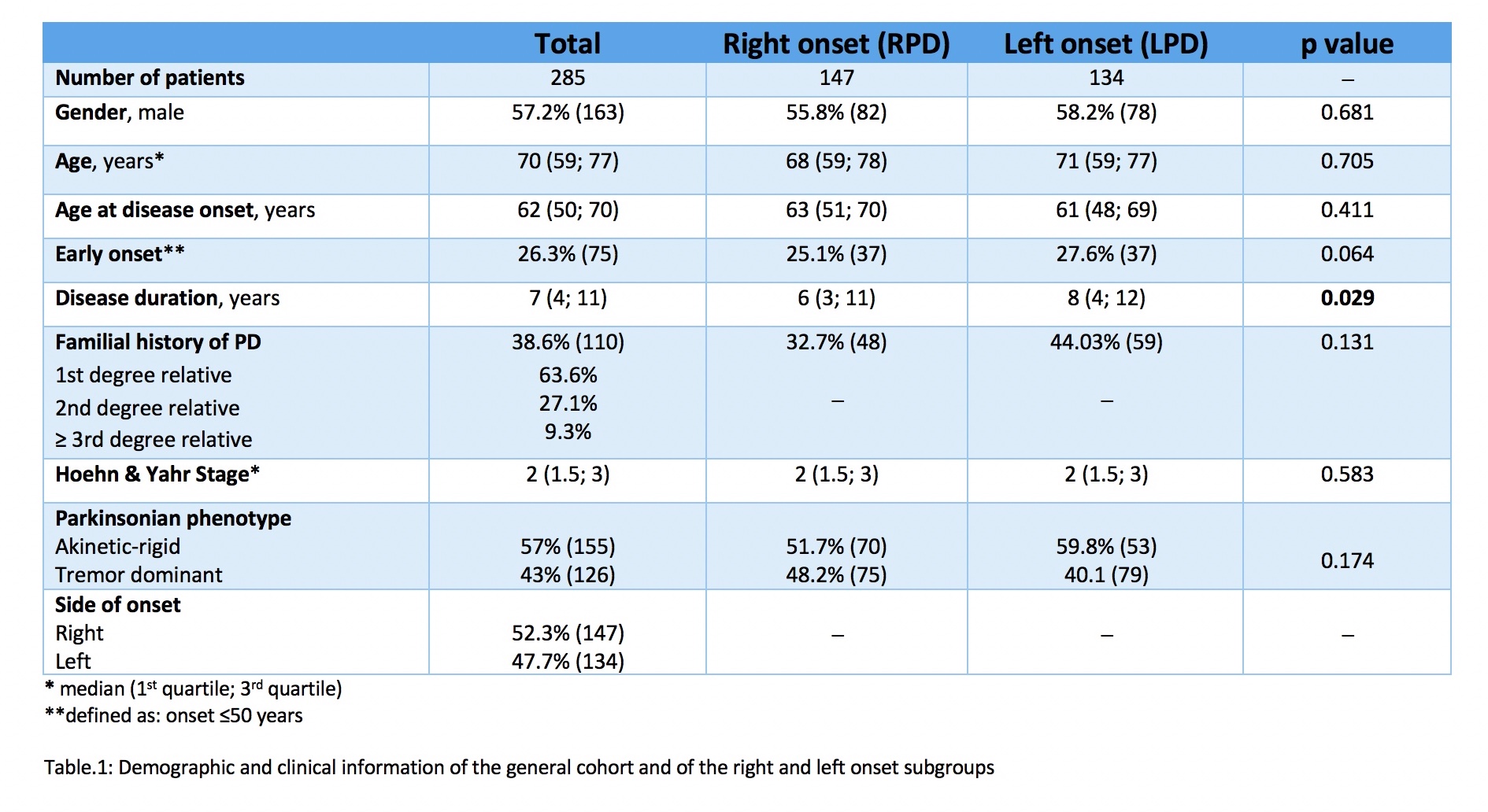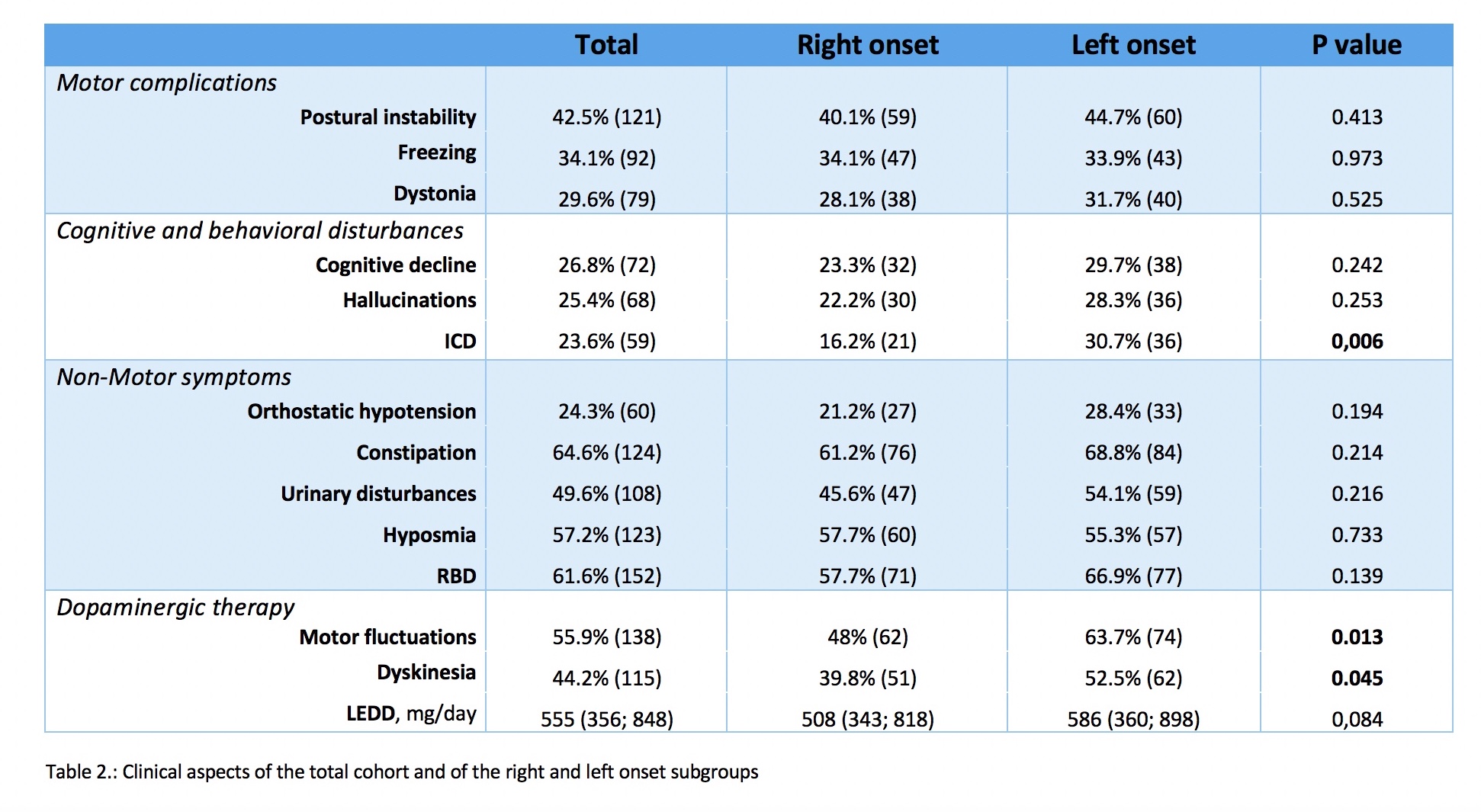Session Information
Date: Sunday, October 7, 2018
Session Title: Phenomenology and Clinical Assessment Of Movement Disorders
Session Time: 1:45pm-3:15pm
Location: Hall 3FG
Objective: To describe demographic and clinical characteristics of a cohort of 285 consecutive PD patients and to understand the phenotypic differences of right onset (RPD) and left onset PD (LPD).
Background: Previous studies on the phenotypic differences between RPD and LPD investigated only cognitive function, with discordant results[1].
Methods: In this retrospective study, all patients diagnosed with PD by a movement disorders specialist between 2013 and 2018 at Ospedale Maggiore Policlinico, Milan, Italy, were enrolled, with a total number of subjects of 285. From all available clinical records and updated to the last available neurological assessment, their clinical-demographic data were collected and grouped into 5 thematic areas: demographic characteristics and disease history, motor complications, cognitive or behavioral disturbances, non-motor symptoms (NMS), dopaminergic therapy and its side effects. We analyzed the clinical data of the total cohort, and afterwards of the two subgroups, right onset and left onset.
Results: Our general population does not seem to differ from average demographic characteristics of PD patients described in literature, with a slight predominance of male gender (57.2%) and a median age at disease onset of 62 years. In approximately 25% of patients motor symptoms were developed before 50 years. The presence of familial history is slightly higher than previous reports: 38.6% of patients have at least one case of PD among their relatives, and in 63.6% of familial cases a first degree relative is affected. Regarding the comparison between the RPD and LPD, demographic and disease history aspects do not suggest significant differences, except for longer disease duration in LPD (median 8 years vs 6 years, p 0.029). As for cognitive, behavioral and NMS, all seem to be more frequent in LPD, but only ICD reached statistical significance (30.7% vs 16.2%, p 0.007). Similarly, dopaminergic drugs side effects were significantly more common in LPD (motor fluctuations: 63.7% vs 48%, p 0.013; dyskinesia: 52.5% vs 39.8%, p 0.045).
Conclusions: The higher frequency of many phenotypic aspects of PD in patients with disease onset on left limbs may be due to a physioanatomic reason, related to the asymmetry of dopaminergic circuits in the CNS involved in the two subgroups of patients. Nevertheless, a significant impact of longer disease duration and higher dopaminergic drugs dosage in this subgroup cannot be excluded. It is our aim to investigate this findings by means of a prospective study.
References: [1] R. Erro, G. Santangelo, M. Picillo, C. Vitale, M. Amboni, K. Longo, F. Giordano, M. Moccia, P. Barone, and M. T. Pellecchia, “Side of onset does not influence cognition in newly diagnosed untreated Parkinson’s disease patients.,” Parkinsonism Relat. Disord., vol. 19, no. 2, pp. 256–9, Feb. 2013.
To cite this abstract in AMA style:
G. Lazzeri, G. Franco, E. Monfrini, E. Frattini, I. Trezzi, L. Borellini, G. Ardolino, F. Cogiamanian, A. Di Fonzo. Retrospective study on a cohort of 285 PD patients: Does the side of onset influence the global clinical phenotype? [abstract]. Mov Disord. 2018; 33 (suppl 2). https://www.mdsabstracts.org/abstract/retrospective-study-on-a-cohort-of-285-pd-patients-does-the-side-of-onset-influence-the-global-clinical-phenotype/. Accessed December 12, 2025.« Back to 2018 International Congress
MDS Abstracts - https://www.mdsabstracts.org/abstract/retrospective-study-on-a-cohort-of-285-pd-patients-does-the-side-of-onset-influence-the-global-clinical-phenotype/


